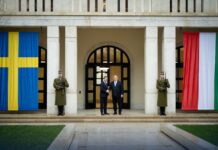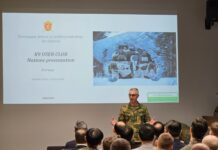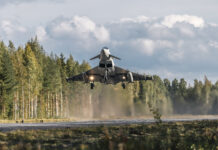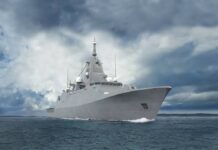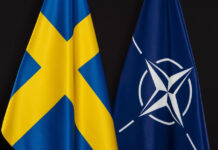Finland has consistently taken a pragmatic approach to defense policy. When the Cold War ended, most Western countries reduced their defence spending and shifted to small professional armies. Finland, however, took a different approach – not least because of its 800-mile border with Russia. Helsinki insisted on conscription and a large defense budget. ESD had the opportunity to talk to Lt.Gen. Timo Kakkola, Deputy Chief of Staff, Logistics and Armaments of the Finnish Ministry of Defence.
ESD: Can you briefly elaborate on the tasks and responsibilities of the Resource Policy Department in the Finnish MoD?
Lt.Gen. Kakkola: Resource Policy Department (RPD) is one of the three departments in the Finnish MOD. It is responsible for outlining defence material policy in the Finnish defence capability building process as well as directing the personnel and employer policy, real estate and environmental policy. RPD also gives guidance to the ICT-policy within the defence administration.
RPD consists of five units having the responsibility of the above-mentioned main tasks; Materiel Unit, Strategic Projects Programme, Personnel Unit, Real Estate and Environment Unit and ICT Unit. RPDs’ main task is to give MoD level guidance in these areas within the whole defence administration, and in broader terms, to secure needed resources for national defence within these specific areas, including in preparation for times of crisis.
In defence materiel procurement, RPD gives materiel policy guidance to the Finnish Defence Forces, coordinates procurements, and decides on case-by-case basis the procurement model. RPD also defines security of supply and industrial participation requirements based on national requirements. RPD runs the Defence Administration Commercial Board which gives its endorsement in all procurements with a value exceeding EUR 15 million, subject to procurement decision by the Minister of Defence.
Finnish capability building is based on long-term planning. National strategies like governmental programs, foreign and security policy reports and defence reports lay the political foundation for defence capability planning. Based on that, Defence Command Finland (DCF) develops, together with the services, a detailed-long term development program which is the base for national capability building and procurement. RPD coordinates the procurement process and Defence Forces Logistic Command is the procurement authority subordinated to the DCF.
ESD: What are the lessons learned from the war in Ukraine? Has the war lead to new procurement priorities or an adaptation of the Finnish procurement policy?
Lt.Gen. Kakkola: Finnish defence administration material policy and administrative acquisition guidance/regulation is based on mandatory legal rules and principles. EU and national procurement law promotes competition, which is fundamentally an obligation running through the legislation. The law does identify circumstances where the obligation to have a wide, transparent and non-discriminatory competition is not mandatory. These situations are covered by exceptions within the said legal regime. In general, the on-going crisis has had very little impact to Finnish material policy or procurement procedures. Security of supply has always been a requirement of great importance to us. No doubt the war in Ukraine has highlighted this and maybe somewhat shifted the focus to a more pragmatic understanding of Security of Supply. Another observation is the sudden and urgent need for many countries to raise their stocks and supplies, which has led to delays in deliveries.
ESD: Are you investing increasingly in the protection of the Finnish/Russian border?
Lt.Gen. Kakkola: The Finnish Border Guard is a security authority functioning under the Ministry of Interior. The Frontier Guard is responsible for border safety and security, border surveillance, border checks as well as maintaining order at Finland’s border areas in all circumstances. Securing the border areas is based on adjustable threat assessments that implicates selecting focused capabilities in order to facing the needs and challenges. Sustaining and further developing of technical systems and material can be seen as a routine action and everyday function in the Border Guard. Based on Finnish Legislation concerning border security, the Border Guard has solid mandate to build up a border obstacles (ex. fence) whenever decided. During wartime Finnish Border Guard can be merged to FDF (Finnish Defence Forces). All the necessary planning has been made during peacetime.
ESD: Against the background of Finland’s forthcoming NATO membership, what kind of armament cooperation already exists within the framework of NATO?
Lt.Gen. Kakkola: Finland has longstanding armaments cooperation with NATO due to our long-term and stable position as a partnership country. We are already represented in many of the working groups under the CNAD, like NAAG, NAFAG and NNAG and their several subcommittees. Finland has also had a representative in the NSPA for over a decade. Full NATO membership will, of course, open some new working groups dedicated to members only. Finland’s presence in the current working groups will also increase along with membership. We are looking forward to expanding our existing armaments cooperation in this regard.
ESD: What plans are in place for the equipment of Soviet origin that is still in service with the Finnish defence forces – assault rifles, artillery systems, etc.?
Lt.Gen. Kakkola: Finnish Defence Forces has some equipment of Soviet Union origin in its inventory. Such material includes for example transport equipment, artillery weapons etc. Such remaining material will be maintained until the end of its capability life-cycle. Most of such materiel has been purchased as surplus from the former East-Germany. FDF has a spares stock enabling self-sufficient maintenance of the materiel until end of life-cycle.
ESD: What is the status of the ongoing cooperative armament efforts among the Nordic countries? Does the Norwegian company Kongsberg, as one of the shareholders of Patria, have a special role?
Lt.Gen. Kakkola: Nordic countries have cooperated in the field of armaments within the NORDEFCO framework. The basis for this cooperation is laid in the defence materiel agreement between respective countries, which was signed in 2015. This agreement has later been complemented with annexes focusing on joint procurement, security of supply and export control.
With the proper legal framework in place, the Nordic countries are exploring opportunities of practical cooperation in related fields. Some joint projects have been initiated and currently there is e.g. ongoing work in the area of security of supply. Opportunities for joint procurement are also systematically scanned.
Kongsberg is an important player both as a provider of some key capabilities to Finnish Defence Forces (FDF) as well as being the other major shareholder of Patria. When taking part in the invitation to tender by the FDF it does however not have any special role because of its position but is treated as any bidder according to the principles described in the relevant defence procurement legislation, namely – equal, non-discriminative and transparent treatment of all economical operators.
ESD: Initiated by the Obama administration as European Phased Adaptive Approach, NATO is developing a European BMD capability. Does Finland plan to join this effort? Or do you have different plans?
Lt.Gen. Kakkola: In general, Finland as a future NATO member supports initiatives that contribute to the Alliance’s common defence and deterrence. Regarding the potential Finnish role in this capability, we will engage in consultations at the national level and with all partners as appropriate.
ESD: Compared to other European nations Finland’s defensive capabilities are based on a huge number of civilian reservists. What effect does that have on procurement objectives? Can you elaborate on the procedures for the “procurement” of infrastructure, namely bunkers?
Lt.Gen. Kakkola: Not surprisingly, a major challenge concerning acquisitions and having a large reserve is the volume itself and all that that comes with it, storage, lifecycle management etc. The notable number of reservists can bring surprises in seemingly ordinary acquisitions. There are a great number of countries with less wartime strength and products that work well for others might require modifications to our need, which is always costly. In general though the overall concept we have has been in place for decades and thus poses no extra challenges. Bunkers mainly follow the same policies and guidelines as other acquisitions.
ESD: What plans are in place with regard to Finland’s future role as a NATO Host Nation?
Lt.Gen. Kakkola: Finland has signed HNS MOU with NATO 2014 and HNS TA May 2022. Finland has acted as a Host Nation for troops in exercises since 1990, and hence, the issue is not unfamiliar to us. However, of course, Finland´s future role as a NATO Host Nation will be specified within operational and defence planning processes with NATO.
ESD’s interview questions were asked by Jürgen Hensel.





